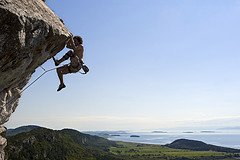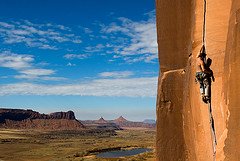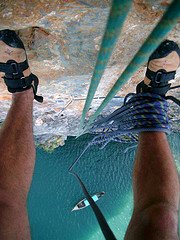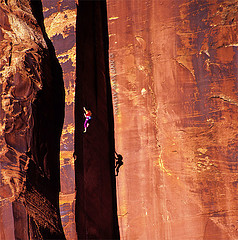|
ROCK CLIMBING HISTORY
Rock Climbing History is enticing. Since man first met the rock, there have been rock climbers. This sounds simplistic but it is the truth! Rock climbing has been a necessity for people traversing mountainous regions throughout history. Ancient civilizations have lived and built their homes on or in cliffs and rock ledges as a form of protection. There is pictorial evidence of men climbing rocks in Chinese watercolors from 400 B.C. Rock climbing techniques have been employed by several conquering armies throughout history to not only traverse mountainous regions to invade areas, but also to siege castles and other fortresses and breach the walls and defenses of these structures.
In rock climbing history we see rock climbing was also used to gather food in medieval times; there are numerous reports of climbers (with the aid of just a length of rope if they were lucky) whose job it was to collect sea bird eggs from English cliff faces to sell as food.
ROCK CLIMBING HISTORY AS A SPORT
Rock climbing as a sport rather than as a means of getting from A to B has existed since the late 1800’s. The Victorian era is well known as a period in time when nature and the study and exploration of the natural world was extremely fashionable. This interest lead to rock climbing taking off as a sport in its own right during this period. Prior to the 1880’s rock climbing was perceived as being a component of mountaineering and not a standalone sport. Walter Parry Haskett Smith was a solo climber who completed the first ascent of the Napes Needle in the late 1880’s and this climb is traditionally seen as the birth of rock climbing as a sport. This climb was extremely well publicized at the time and as a result of this publicity over 60 climbers at a time would meet to climb this natural peak. Emilio Comici is regarded by many as the father of modern rock climbing. He was a climber in the 1930’s and was the inventor of many climbing aids such as the solid belays, hanging bivouacs and the use of the trail/tag line. Comici is famed as being the originator of big wall climbing and the techniques involved. The general public (those people outside of the sports of both mountaineering and rock climbing) still thought of rock climbing as a component of mountain climbing and not a separate sport for many years to come. Looking back at rock climbing history, it was not until the 1950’s that the general public began to perceive rock climbing as being a sport of its own.
Up until the 1950’s, rock climbing was perceived as having two functions. It was seen as a component of mountain climbing and as a necessary part of traversing some mountains, a means of obtaining the summit. Rock climbing was also seen as a training activity- a way for mountain climbers to achieve fitness and hone their skills for the “real” challenge of mountain climbing!
ROCK CLIMBING HISTORY GRADING SYSTEM
As rock climbing became better known and more popular, a grading system was introduced to allow climbers to measure both the difficulty of the climb and measure the climber’s ability. Rock climbing gained popularity all over the world and as travel and information sharing were not as easy to do as they are today the grading systems and climbing styles of different countries developed separately. This means that many countries have their own grading system and individual climbing styles that have developed to suit their particular geography, terrain and availability of climbing gear.
As the sport has developed the top rated climbs have actually become shorter, but much more technically challenging. In the early days big wall climbs that took several days were considered the height of the sport.
ROCK CLIMBING HISTORY GEAR
There is a huge range of modern rock climbing gear available for rock climbing, this gear ranges from safety equipment to equipment that aids a climber and makes the climbing process easier. The first piece of rock climbing equipment most people think of is rope; ropes are used both as a safety device and also by some climbers with the aid of an ascender to climb. Ascenders are pieces of mechanical equipment that a climber uses to climb up a rope. Ascending is very popular in adventure racing. Helmets are probably the next piece of equipment that the average person would think of when considering rock climbing equipment. Carabineers, quickdraws, belay devices, rappel devices, and harnesses are all devices that are used with or on the climbing rope. Carabineers are used as connectors and there are several different types of carabineers each used for different connections. Quick draws are devices that the climbing rope runs through with minimal friction and are used to attach the ropes to anchors or other protection. Belay and rappel devices are both devices that are used on climbing ropes for the purposes they name. Harnesses are also self explanatory – it is the piece of safety equipment that connects the climber to the climbing rope. Climbers also use protection devices – devices that are secured into the rock face onto which the climbing rope is attached. There are three main types of protection devices or pro’s nuts, hexcentrics and spring loaded camming devices (SLCD’s). Rock climbing encompasses many styles these are: indoor climbing, bouldering, traditional rock climbing, free rock climbing, aid climbing, solo climbing, alpine climbing and ice climbing. Each of these individual specialties has their own basic skills and levels of experience necessary. It is highly recommended that you should get proper and appropriate training in the basic skills of rock climbing from a reputable club or training association. A search of the internet will reveal several clubs and organizations in your area that will be able to instruct you in the basics of rock climbing.
ROCK CLIMBING HISTORY SKILLS
Contrary to popular opinion you do not need super human upper body strength to rock climb; you will find that your legs and feet will be used more than your hands in your efforts. The main problem most new comers to the sport have is not physical or related to fitness – you will be able to climb and your strength and fitness will increase as you try harder climbs. The major hurdle for most new climbers is mental you will need the ability to be able to concentrate for long periods of time and be able to overcome any fears or phobias you may have about the void below you or placing your life in your climbing partner's hands. When I did my first ascent the rope was up against a rock ledge. I was not experienced enough to know how to remove my ascenders or self-rescue and I had no footholds to push myself away from the wall. I hung in the air for about 20 minutes, spinning around...looking around...getting jittery- while I waited for help. It was very nerve-racking, but after each rappel and climb it became easier. I use a lot of mental techniques to aid my fear of heights. Another skill you'll need to master is tying knots. This can easily be accomplished by practicing at night during your down time, while watching tv.
|



